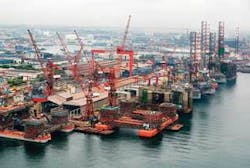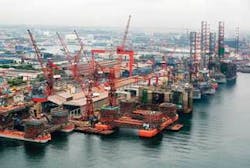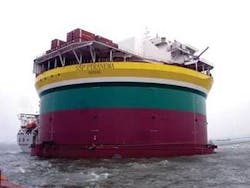Southeast Asia yards continue to expand
Gurdip Sing, Contributing Editor
Southeast Asian shipyards and fabricators are busy through to 2011 and report a bullish outlook through 2014 for across-the-board work, including newbuilds, converting tankers into floating production units, service vessels construction, and onsite modification, repair, and maintenance of offshore platforms.
Keppel FELS is already making plans to meet the growing industry needs.
“To cope with this demand, we will invest in new shipyards as, when, and where the market demands for our services,” says Michael Chia, executive director for Keppel FELS Ltd.
The challenges to meeting the enormous demand for facilities and skilled personnel, however, are tremendous.
Among Keppel’s planned yard investments is a potential yard in Vietnam, Chia says.
Meanwhile, Keppel is investing in its facilities at Keppel yards worldwide, among which are numbered several new low-cost yards in China, to stay ahead of competition.
Keppel FELS also is focusing on new technologies, including specialized vessels to operate in the icy regions of the arctic and shallow-water winter environments.
“We must be mindful that success often begets its own challenges,” cautions Mohammed Hassan Marican, president and CEO of Petronas, Malaysia’s state-owned oil and gas company.
Petronas is involved in exploration, production, processing, retailing, and services, including the Malaysia Marine and Heavy Engineering (MMHE) yard in southern peninsular Malaysia.
Hassan Marican points out that drilling rig rates increased by more than 200%, oil country tubular goods prices increased by about 35%, and steel and line pipe prices increased by about 40% against a >20% increase in crude oil prices in 2006. While lead time for securing material, equipment, and machines is getting wider and wider, the industry also is feeling the crunch of a shortage in professional manpower.
Vendors and suppliers are working feverishly to keep pace with shipyards and fabrication yards to ensure materials are in the hands of the yards so that final projects can be completed on time and on budget.
Demand is high and will likely go higher because energy consumption demand is getting stronger, with more challenging projects in deepwater basins and frontiers areas.
“We are constantly discussing our requirements with vendors to ensure we get equipment and machines delivered on time,” says Chia. Still, the lead times are long. Engineering equipment lead time is 24 months, drilling equipment 16-30 months, and subsea equipment is much longer, Chia says.
Upgrading for the boom
MMHE, a subsidiary of Petronas through another cash-rich shipping subsidiary MISC Bhd., is just about finished with a major expansion program that opens the door to new construction and upgrade work. The yard expects to complete a new quayside bulkhead or jetty by the end of next year to handle projects for the Malaysian deepwater field development program.
Earlier this year, MMHE completed the Kikeh deepwater project, which included a spar and an FPSO.
MMHE is also on schedule to expand an existing 12,000-metric-ton (13,228-ton) jetty to 20,000 metric tons by 3Q 2008 and is building one of the largest workshops in the region. The new facility will be 80 m (262 ft) wide, 400 m (1,312 ft) long, and 40 m (131 ft) high.
With these facilities completed, MMHE will be ready for any deepwater project around the world, the company says. The yard has been growing rapidly both in volume of work and technology. It has also been involved in rejuvenating and refurbishing existing facilities.
Compatriot Ramunia Holdings Bhd is raising money through equity and debt to fund an ongoing $103.9 million expansion at its existing fabrication yard in Johor, on Malaysia’s southern peninsula.
“We are reinvesting everything we have back into the company. It is a growing company,” Ramunia Chairman Azizul Rahman told shareholders following approval of a private placement of 45.5 million new shares in Ramunia. The funds raised from this process will go in part to fund the two-year expansion at the Teluk Ramunia fabrication yard, which is due for completion by Oct. 2008.
Ramunia is acquiring land to nearly double it yard to 68 hectares (168 acres) from the present 36 hectares (89 acres) and will increase fabrication capacity by 170%.
Adding capacity
In China, Yantai Raffles Shipyard is adding the world’s largest gantry crane to lift marine structure as heavy as 20,000 metric tons (22,046 tons).
The company believes the upgrades will allow it to secure far bigger and more complex projects in the near future. One facet of the expansion and upgrade plan is to increase semisubmersible capacity. The yard’s goal is to reach 10 semisubmersibles per year.
The Yantai yard in Shangdong province, China, will benefit from the company’s planned investment.
YRS remains firm in its one-yard policy despite the boom. This policy is based on history. Former industry downturns led to global yard capacity shrinking and many shipyards closing shop.
According to YRS, most exploration and production will take place in China to meet the demand of the growing market. China is carrying out several huge oil and gas projects to meet its growing energy needs. Most of the associated offshore and marine activities are expected to take place by 2015.
Kencana Petroleum Bhd., based in Lumut, Perak, in northern peninsular Malaysia, has completed a $14.5-million expansion at its fabrication yard, extending to 67 hectares (166 acres) from 24 hectares (59 acres) over a span of three years. The yard has added workshops, two jetties with capacity to load out 12,000-metric-ton (12,228 tons) and 5,000-metric-ton (5,511 tons) structures, and has strengthened the wharf.
Further extension is being planned at an adjacent site as Kencana moves on to handle jackup rigs, semisubmersible units, and tender assisted drilling units (TAD). The yard is working on the self-installed relocatable platform for the Maari field off New Zealand.
“We are tendering for more projects including two TAD units and one jackup rig,” says Omar Mohammed Isa, Kencana COO.
New yards emerge
Among the new players, the Kuala Lumpur-based engineering company Offshore Works Sdn. Bhd. is looking for a yard in Malaysia or Indonesia.
The company specializes in providing onsite repair and maintenance services for offshore platforms. Director Azlin Khalid says growth will have to come through expansion. He believes Offshore Works needs a 100-150 hectare (247-371 acre) yard in the region.
“Our objective is to have a yard for our two-year-old business of retrofitting, maintenance and carrying out minor onsite fabrication works,” Azlin says.
Offshore Works is preparing to invest $28.9 million in a new yard within the next year or so. Azlin estimates work for a company the size of his is in the range of $869 million to $1.2 billion a year in Southeast Asia.
Streamlining for service
With rising construction and material costs, oil companies have been seeking onsite services as well as yard capacity. Some of the onsite services target de-bottlenecking and retrofitting platforms to tie in new production from fields within the vicinity.
Fields that were uneconomical when crude oil was priced at $25/bbl have become economical with oil at $60/bbl and are being developed at a fast pace. Many are still viable only as tiebacks to existing production facilities.
De-bottlenecking of platforms has been carried out for many years, according to Abdullah Karim, managing director and chief executive officer of Petronas Carigali Sdn. Bhd., the upstream unit of Petronas.
Abdullah says fields within 10-30 km (6-19 mi) of existing platforms are being tied back through extended subsea networks.
Projecting offshore services demand for the coming years, Abdullah sees new rig supply peaking in 2010, beginning in the second half of 2009. Interestingly, Abdullah expects rigs built during the 1980s to retire from 2014 or 2015 onwards, which will create a new replacement demand.
Of critical concern now and in the future are the rising costs of material and equipment, which look as if they will continue to increase this year, Abdullah says.



